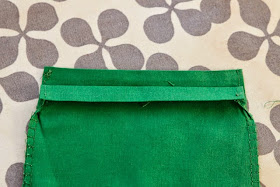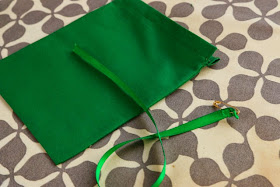Kantha stitching and a little bit more. A perfect travel or watching TV while stitching kind of a project. Here are some snippets.
Tuesday, 19 August 2014
Kantha Stitching - a sneak peak
A little look at a project that has been in progress for well over a year. I pick it up, I put it down, I come back to it when I'm ready to work on the next installment.
Kantha stitching and a little bit more. A perfect travel or watching TV while stitching kind of a project. Here are some snippets.
Kantha stitching and a little bit more. A perfect travel or watching TV while stitching kind of a project. Here are some snippets.
Sunday, 17 August 2014
Tiny drawstring bags for Montessori reading materials
It started with a request from OneLittleImps' teacher last term to repair some aprons the kids use, and next I know I have agreed to make little draw string bags in pink and green and blue....
.. agreed to make 36 of the fiddly little suckers! LittleImp goes to a local Montessori school, and these little bags will hold the relevant colour coded levels of reading materials for her class room.
Cut a rectangle 5.25" x 13" from your chosen fabric.
Mark each end on both edges at two points as shown - at 0.25" and 1.25". These marks are on what will become the inside of the bag.
Fold over the first 0.25" as marked & iron a fold across each short end.
Fold the bag right sides together, matching up the short edges.
Sewing machine time. Line up your needle with the 1.25" mark and straight stitch using a 1/4" seam down each long edge (to reduce fraying you can either use an edging stitch here as I have, or zig zag down each edge after the straight stitching).
Back to the ironing board. Fold back & iron the top 1" of raw edge as shown
Using a straight stitch sew down each of these side folds. The pictures show how I did this - sew down one side...
...then turn the fabric & turn & sew back up the other side (I also reinforced with a few back & forward stitches at the point where the side seams meet given these little bags will take a bit of use by little fingers).
This is what it should then look like. Repeat on the other side.
Back to the ironing board to iron down what will become the casing for the drawstring. Use the 1.25" mark as a guide & fold the edge down to meet this point (or there abouts) & iron the fold.
Repeat on the other side and then straight stitch each of these folded edges down, keeping your stitches close to the fold. Make sure to secure the stitching well at the beginning and end, again to withstand the forces of the drawstring pulling.
Snip all the loose/excess bits of thread. Turn bag right side out & use a sharp-ish object to poke out the corners.
Now for the ribbon. Cut 2x13" lengths of ribbon for each bag. Use a safety pin to then thread one ribbon through both casings. (If the ribbon starts to fray then try folding it over a few times before pinning it with the safety pin.)
Once you have passed through both casings then knot the ends of the ribbon together (as seen on the left side below). Take the next piece of ribbon & thread this through both casings, starting from the other (non-knotted) side, once all the way around join the ends of the ribbon & tie another knot. All done!
Only 35 to go...
.. agreed to make 36 of the fiddly little suckers! LittleImp goes to a local Montessori school, and these little bags will hold the relevant colour coded levels of reading materials for her class room.
Here is how to make just one bag.
What you need - fabric & ribbon. This bag is pretty tiny - approx 5"x6". Obviously you can upsize the dimensions & still follow the same instructions below.Cut a rectangle 5.25" x 13" from your chosen fabric.
Mark each end on both edges at two points as shown - at 0.25" and 1.25". These marks are on what will become the inside of the bag.
Fold over the first 0.25" as marked & iron a fold across each short end.
Sewing machine time. Line up your needle with the 1.25" mark and straight stitch using a 1/4" seam down each long edge (to reduce fraying you can either use an edging stitch here as I have, or zig zag down each edge after the straight stitching).
Back to the ironing board. Fold back & iron the top 1" of raw edge as shown
Using a straight stitch sew down each of these side folds. The pictures show how I did this - sew down one side...
This is what it should then look like. Repeat on the other side.
Repeat on the other side and then straight stitch each of these folded edges down, keeping your stitches close to the fold. Make sure to secure the stitching well at the beginning and end, again to withstand the forces of the drawstring pulling.
Snip all the loose/excess bits of thread. Turn bag right side out & use a sharp-ish object to poke out the corners.
Now for the ribbon. Cut 2x13" lengths of ribbon for each bag. Use a safety pin to then thread one ribbon through both casings. (If the ribbon starts to fray then try folding it over a few times before pinning it with the safety pin.)
Once you have passed through both casings then knot the ends of the ribbon together (as seen on the left side below). Take the next piece of ribbon & thread this through both casings, starting from the other (non-knotted) side, once all the way around join the ends of the ribbon & tie another knot. All done!
Thursday, 14 August 2014
Shower cap
The last showercap I made sure lasted longer than those flimsy ones you get free in hotel rooms.
I'm not sure that too many people still use showercaps, but if you do, then this is a pretty easy project to complete...not quite so easy to get a shot of someone wearing it at the end though!
OneLittleImp wasn't playing the game to wear it for a photoshoot, so I had to get creative. Thanks Tigger!
Quick How To:
Make a circle template with newspaper, pencil & string - my cap is 19"in diametre. If you want more frilly-ness then use a bigger circle to start with.
Use the template to cut 1 circle from fabric & one circle from a waterproof layer. I bought a cheap plastic table cloth from a $2 store a while back that I use for waterproofing different projects.
Place the waterproof layer and fabric right sides together & straight stitch all the way around the edge with a 1/4" seam, leaving enough opening to turn right side out.
Trim excess & clip seams before turning right side out.
Use your fingers to roll edge flat as much as possible while you top stitch all the way around using a 1/4" seam to hold the fabric & waterproof layers together at the edge. Change the colours of your top/bobbin thread if needed to match the colours of the fabric & waterproof layers.
Fold the circle into quarters & mark each quarter fold at the edge. This will be used to help with the gathering when you add in the elastic.
Use your own head to measure how much elastic you need - Cut this amount with about 1" extra added. Fold the elastic into quarters as well & mark each quarter fold.
Next, pin the start of your elastic (leaving the extra 1" tail that you will overlap at the end) to one of the quarter marks on the shower cap and then match up the next quarter lines on the shower cap & elastic before pinning these points together.
Back to the sewing machine. Change thread colours again if you need to.
Using about a 1/2-3/4" seam allowance, you now sew the elastic to the fabric. To create the gathers, pull the elastic as you sew with a multipoint zigzag to secure. Once you reach the first quarter mark, match up the next quarter of the shower cap & elastic & repeat. This will form your gathers.
Here are the gathers forming. Once you are all the way around you are all done. How simple is that?!?
...And then she finally let me take a picture!
I'm not sure that too many people still use showercaps, but if you do, then this is a pretty easy project to complete...not quite so easy to get a shot of someone wearing it at the end though!
OneLittleImp wasn't playing the game to wear it for a photoshoot, so I had to get creative. Thanks Tigger!
Quick How To:
Make a circle template with newspaper, pencil & string - my cap is 19"in diametre. If you want more frilly-ness then use a bigger circle to start with.
Use the template to cut 1 circle from fabric & one circle from a waterproof layer. I bought a cheap plastic table cloth from a $2 store a while back that I use for waterproofing different projects.
Place the waterproof layer and fabric right sides together & straight stitch all the way around the edge with a 1/4" seam, leaving enough opening to turn right side out.
Trim excess & clip seams before turning right side out.
Use your fingers to roll edge flat as much as possible while you top stitch all the way around using a 1/4" seam to hold the fabric & waterproof layers together at the edge. Change the colours of your top/bobbin thread if needed to match the colours of the fabric & waterproof layers.
Fold the circle into quarters & mark each quarter fold at the edge. This will be used to help with the gathering when you add in the elastic.
Use your own head to measure how much elastic you need - Cut this amount with about 1" extra added. Fold the elastic into quarters as well & mark each quarter fold.
Next, pin the start of your elastic (leaving the extra 1" tail that you will overlap at the end) to one of the quarter marks on the shower cap and then match up the next quarter lines on the shower cap & elastic before pinning these points together.
Back to the sewing machine. Change thread colours again if you need to.
Using about a 1/2-3/4" seam allowance, you now sew the elastic to the fabric. To create the gathers, pull the elastic as you sew with a multipoint zigzag to secure. Once you reach the first quarter mark, match up the next quarter of the shower cap & elastic & repeat. This will form your gathers.
Here are the gathers forming. Once you are all the way around you are all done. How simple is that?!?
...And then she finally let me take a picture!


































